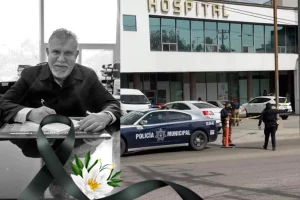CONDENA MH CLÚSTER ATAQUE ARMADO A HOSPITAL ARCÁNGELES
Leer más
San Diego County enters highest and most severe COVID-19 level

Ten days after the Fourth of July, coronavirus activity appears to be on the upswing, according to San Diego County’s latest case and hospitalization numbers, pushing the region into the most severe level of the nationwide COVID-19 activity map maintained by the U.S. Centers for Disease Control and Prevention.
Communities with 10 or more recent coronavirus-related hospitalizations per 100,000 residents are listed in the highest tier, which is color coded orange. San Diego County, said to have 384 total new COVID hospitalizations in a seven-day span ending July 12, reached 11.5 per 100,000. Los Angeles and Orange counties both joined San Diego in the high category for the first time this week, reaching 11 and 15.2 respectively.
The county’s weekly coronavirus update listed 2,191 new cases, somewhat more than the 1,767 listed one week earlier. Local wastewater analysis showed nearly 7.1 million COVID copies as of July 6, the last time the information was updated. The number is up slightly from 5.9 million on June 23.
Today, there are few counties in California not colored orange on the map, a designation that recommends people wear masks indoors. The state, though, has remained mum on requiring its previous indoor mask mandate.
Through Wednesday, the total cumulative number of residents in local non-military hospitals with confirmed or suspected COVID-19 infections was 410, the second day in a row that the number was over 400. It’s the first time the number has exceeded that mark since early March. However, the current number of hospitalizations remains far below the winter peak, which surpassed 1,200 during the first Omicron surge in January.
Health providers learned over the winter that though Omicron produced less-severe disease than its predecessors, it was still able to create gridlock in emergency rooms as droves of health care workers tested positive and called in sick by the hundreds at a moment when many were coming in for a wide variety of health problems including but not limited to coronavirus.
A new highly transmissible coronavirus subvariant called BA.5, said to be nearly 10 times more infectious than original strains, has been widely cited as the reason that cases continue to surge. San Diego County genetic analysis of local wastewater led by a group of researchers at UC San Diego and Scripps Research found that, as of July 6, 72 percent of samples collected and analyzed were BA.5.
The question of the moment is: Will this latest wave have similar effects on local health care with too many workers in front-line, difficult-to-replace jobs getting sick?
In Summerlin, you’ll find all types of housing at a full range of price points, from apartments to mega mansions. There’s a buzzing downtown with popular restaurants and shops, state-of-the-art movie theaters, office buildings, and even a modern…
Sharp Health Care, the region’s largest health care system with more than 20,000 employees, reported that its collective number of employees calling in sick has hovered in the 500s for the past month, hitting 600 last week and reaching 567 Wednesday.
So far, said John Cihomsky, Sharp’s vice president of communications, it has not yet been necessary to delay pre-scheduled operations and procedures as was the case during the winter surge.
“(We have) no reduction in services at this time, and we’re filling the staffing gaps with incentives to take extra shifts and travelers,” Cihomsky said in an email, referring to nurses who take short-term contracts to help handle unexpected surges in demand.
Dr. Ghazala Sharieff, Scripps’ chief medical officer of acute care and clinical excellence, said it is a similar situation at the five-hospital network. Staff are calling in sick at greater rates, but not in numbers that have yet forced any significant shift in services. Scripps Health reported about 100 sick calls per day.
She said she and others are concerned about what may be to come, with several large events on the calendar including San Diego’s Comic-Con International, by far the region’s largest indoor event which takes over the San Diego Convention Center and most of the surrounding downtown area next weekend.
The event requires all attendees to wear face coverings regardless of vaccination status in addition to proof of “full COVID-19 vaccination status or proof of a negative COVID-19 tests taken within 72 hours” of arrival.
Sharieff hoped that precautions will work, not just for the general populace, but also for employees who will attend.
“Right now, we’re able to address and manage,” she said. “But with the big events that are coming, we’re worried about what might come.”
Créditos: Comité científico Covid




